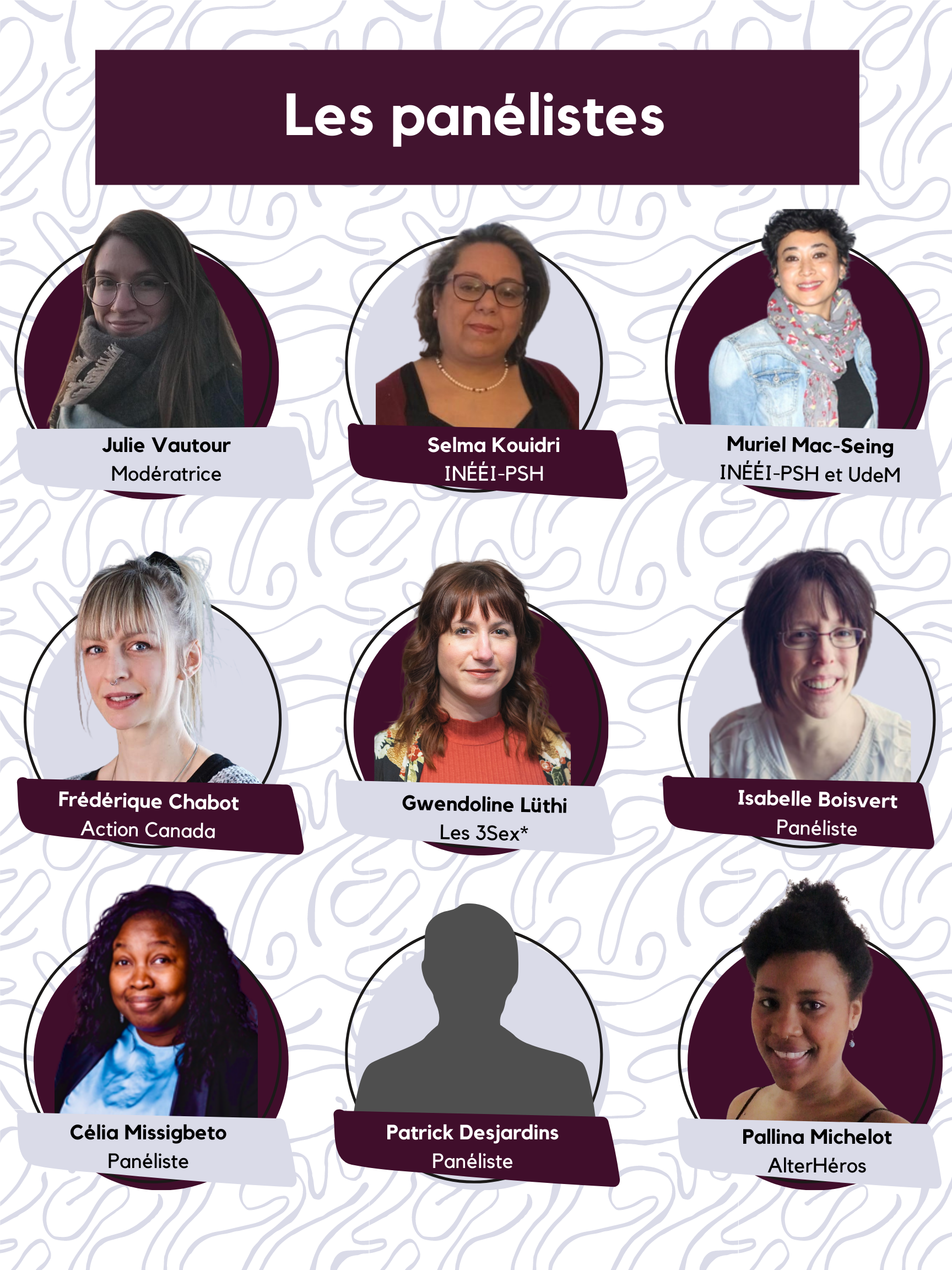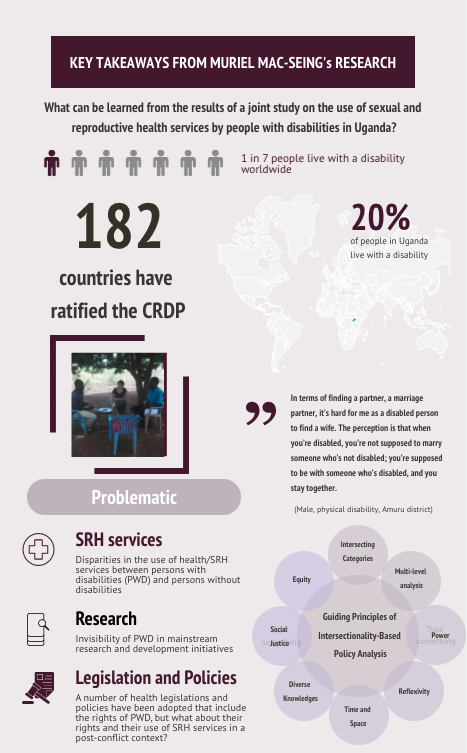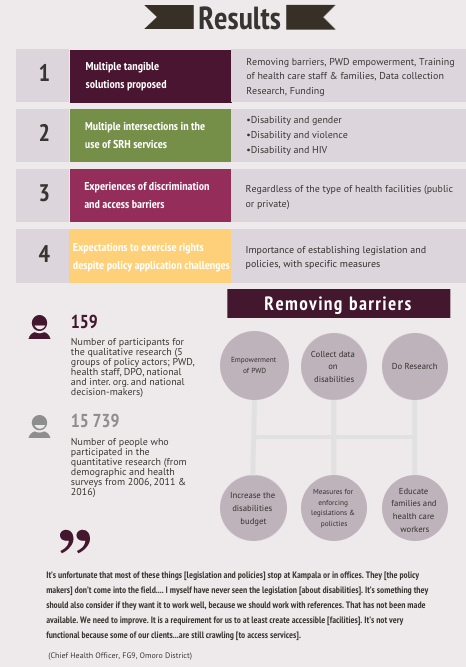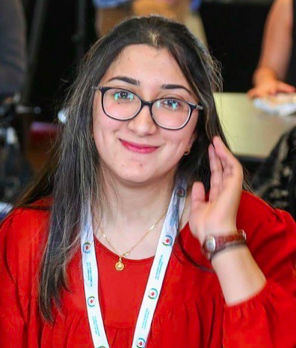
On Dec 3, 2021, on International Day of Persons with Disabilities, the Equal Futures Network, in partnership with the Institut National pour l’Équité, Égalité et l’Inclusion des personnes en situation de handicap, hosted a panel discussion examining the needs and intersecting barriers that people living with disabilities face when it comes to fulfilling their sexual and reproductive health and rights (SRHR) needs both globally and within Canada.
Participants heard testimonies from people living with disabilities, who shared their birthing and parenting journeys highlighting the unique barriers and challenges they faced. We then heard from SRHR experts from Action Canada for Sexual Health and Rights, Les 3Sex* and AlterHéros.
Finally, this was our first collaborative panel in French (with English and LSQ Interpretation), a total of 51 people attended the session. Here is what we heard:
AREAS REQUIRING TARGETED SUPPORT
Sexual and Reproductive Health is not limited to the absence of diseases or dysfunction but is rather defined by a “state of physical, emotional and social well-being in relation to all aspects of sexuality and reproduction” (Guttmacher Institute, 2018). Therefore, SRHR embodies the rights of all individuals to make decisions in regards to their bodies and to access the services to support these rights.
SRHR is based on the human rights of all individuals to:
- “Have their bodily integrity, privacy and personal autonomy respected;
- Freely define their own sexuality, including sexual orientation and gender identity and expression;
- Decide whether and when to be sexually active;
- Choose their sexual partners;
- Have safe and pleasurable sexual experiences;
- Decide whether, when and whom to marry;
- Decide whether, when and by what means to have a child or children, and how many children to have;
- Have access over their lifetimes to the information, resources, services and support necessary to achieve all the above, free from discrimination, coercion, exploitation and violence” (Guttmacher Institute, 2018).
However, there is very little research conducted on the intersections of SRHR and people living with disabilities and from the advocacy efforts of disability communities, we know that in practice the rights listed above are often not respected. In order to better understand the diverse needs of the disabled community, there needs to be more research that is driven by community members, centering their voices and lived experiences.
KEY TAKEAWAYS FROM MURIEL MAC-SEING’S RESEARCH
What can be learned from the results of a joint study on the use of sexual and reproductive health services by people with disabilities in Uganda?
SIGNIFICANT GAPS AND KEY CHALLENGES
- Blind spots in the SRHR movement:
Even though SRHR is getting more and more attention at the national and international level, certain marginalized populations, such as people living with disabilities, are often left behind.
- Invisibility: There is lots of research being done on SRHR, but not many looks specifically at the barriers faced by people living with disabilities. When included, they are often mentioned only briefly, but more often than not they are completely absent from SRHR policies, mainstream research and development initiatives.
- Discrimination and obstetric violence: It is often assumed that people with disabilities cannot or should not become parents. Therefore, those who choose to become parents face a lot discrimination in their parenthood journeys. They experience microaggressions, such as unsolicited comments or advice, medical staff ignoring the parent with a disability and only addressing/talking to the able-bodied parent, to obstetric violence, such as unadapted equipment and untrained staff to meet the needs of labouring people with disabilities and even forced sterilization or forced contraception.
- Isolation and lack of resources: Loneliness is a common feeling during postpartum. However, the level of isolation felt by people living with disabilities during that period is exponential. Many factors contribute to this, including the lack of accessible and adapted resources for new parents living with disabilities. One of the most shocking examples was given by one of the panelists, Celia, who is visually impaired and a mother of a young child. She has been unable to access paratransit because, although she is disabled, she does not use a wheelchair. Further, this service is only available for the person living with a disability and not their partner or children. This is just one example of a barrier that contributes to the isolation she experienced as a new parent.
- Sexual prejudices and myths : It is often assumed that people living with disabilities do not have sexual lives or that they are like children and it is important to protect them, which is often the reason for the lack of SRHR services (Brodwin, Frederick, 2010, p. 37). These popular myths only highlight the needs for people with disabilities to have access to appropriate sexuality education that is sex positive. Check out Gwendoline Luthi’s work from Les 3Sex* for more in-depth information about this topic.
2. Neurodiversity
Just like people living with disabilities, neurodivergent people are marginalized when it comes to SRHR as there is practically no existing research on the (SRH) needs of people on the spectrum. Moreover, we know that neurodivergent people are much more likely to identify themselves beyond gender binarity and heterosexual norms and could truly benefits from resources adapted to their specific realities. These resources need to be created by and for neurodivergent people, just like AlterHéros’s project “Love-Moé comme du Monde!”.
- History of discrimination within the SRHR movement
Sexual and reproductive rights groups have a history of adopting eugenic philosophies and many of the leading figures in the contraceptive movement saw contraceptives and sterilization as a means of controlling the demographics of working class, certain racialized groups or inferior groups deemed “unintelligent”. It is in this spirit of eugenics that Indigenous women and women with disabilities were forcibly sterilized beginning in the early 20th century, a practice that continues today in Canada.
The work that needs to be done to advance the SRHR of people with disabilities requires a thorough analysis of the measures, policies and practices that exist and that disabled communities face in their everyday lives. It is complex because this area is a blind-spot and current structures uphold covertly racist, sexist and ableist these existing structures are. Advancing a more just system is only possible through meaningful consultation and developing solidarity with impacted groups. Their needs must not be added as an aside but included as a central component of all policy and advocacy work. Check out the work of Action Canada for more detailed information and advocacy in this area!
WHAT DO WE DO NOW?
Recommendations
- Meaningful, on-going consultation: Capitalize on the knowledge of people with disabilities (with all types of impairments) as experts, especially in the design, implementation, monitoring and evaluation of inclusive initiatives. It is crucial to build meaningful relationships and consult marginalized groups when it comes to doing this work.
- Adaptive environments and resources : Invest in environments that are adapted for people with disabilities, such as birthing rooms, adjustable gynecological tables, etc., and adapt current support programs to include all areas of disability, not just physical.
- Comprehensive Sexual Education: Ensure that people living with disabilities are included and represented in the sexual education curriculum and that their inclusion provides them with accurate, positive information about their bodies and sexuality.
- Intersectionality: Concretely address the intersectional vulnerabilities of people with disabilities, with budgeted action plans and dedicated human and technical resources.
- Research: There needs to be more systematically collected, analyzed, and reported data that is followed up so that there is accountability in this work.
Resources:
- ACCELERATE PROGRESS Sexual and Reproductive Health and Rights for All (Guttmacher Institute) – (English)
- Regards croisés entre le nord de l’Ouganda et le Québec Droits sexuels et reproductifs des femmes en situation de handicap (Selma Kouidri and Muriel Mac-Seing, Ligue des droits) p.34 – (French)
- The intersectional jeopardy of disability, gender and sexual and reproductive health: experiences and recommendations of women and men with disabilities in Northern Uganda (publication by Muriel Mac-Seing on her research) – (English)
- Analyse des attitudes du grand public à l’égard de la sexualité des personnes en situation de handicap (French)
- Filles sans barrières (DAWN) – (French)
- Girls without Barriers (DAWN) – (English)
- Revue 002 – Sexualités oubliées (featuring an article from panelist Gwendoline Luthi, Les 3Sex*) – (French)
- Balado – Au coin du brasier (Les 3Sex*) – (French)
- Sex, Sexual Health and Disability (Action Canada) – (English)
The Equal Futures Network acknowledges that Indigenous people are the traditional guardians of Turtle Island, on the land also known as Canada








